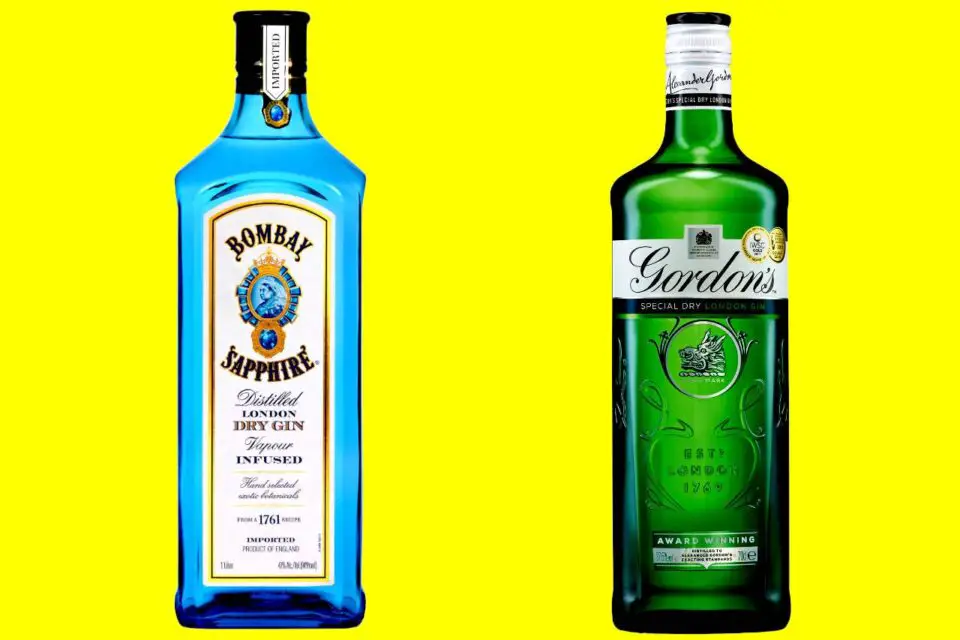READ ALSO: Tanqueray vs Gordon’s & More
Gordon’s Gin vs Bombay Sapphire

If you would like to know more about Gordon’s Gin vs Bombay Sapphire, click here.
To tell you a little bit more about that here, though:
Here’s a comparison of Bombay Sapphire vs. Gordon’s Gin:
Table of Contents
Gordons London Dry Gin vs Bombay Sapphire: Origins & Background
- Gordon’s Gin dates back to 1769, founded by Alexander Gordon in London. It created the classic London dry style and remains one of the world’s bestselling gins—owned today by Diageo.
- Bombay Sapphire is far younger, launched in 1986–87 by International Distillers & Vintners (later Diageo, now owned by Bacardi). It was created during a slump in gin sales, with a distinctive blue bottle and modern marketing tied to colonial-era India symbolism.
Gordons Gin vs Bombay Sapphire: Botanicals & Distillation
- Gordon’s employs a triple‑distilled grain spirit flavored with juniper berries, coriander, angelica root, licorice root, orris root, lemon peel and orange peel. It has remained largely unchanged since 1769. No sugar is added, making it a true dry gin.
- Bombay Sapphire uses the vapour‑infusion method: alcohol vapors are passed through baskets of botanicals. It features 10 botanicals—juniper, coriander, angelica root, orris root, liquorice, lemon peel, orange peel, cassia bark, cubeb berries, and grains of paradise—with a softer, more aromatic, floral and citrus‑spice profile.
Alcohol Strength & Variants
- Gordon’s is sold at various ABV levels depending on market:
- UK: 37.5 % ABV (since 1992)
- North America: 40 %
- Duty‑free/export “Traveller’s Edition”: up to 47.3 % ABV.
- Bombay Sapphire is typically 40 % ABV in UK, Europe, Canada, Australia; higher 47 % ABV in U.S. and export markets.
Flavor Profile & Serving
- Gordon’s is juniper‑forward—clean, crisp, fresh, citrus‑dry, fairly simple and straightforward. Its heavy juniper dominates and may appear one‑dimensional but is considered classic and mixable.
- Bombay Sapphire is more layered and aromatic. Expect citrus zest, peppery spice, floral undertones, almond or earthy grains of paradise notes, and a longer finish. Tasters describe it as more complex, elegant, and better appreciated neat or in cocktails that highlight its botanical nuance.
Personal reviews align: one reviewer said, “Bombay Sapphire is a more complex gin than Gordon’s … with a touch more spice and citrus zest” and another called Bombay “warming, spicy‑sweet … long lingering finish,” whereas Gordon’s was “dull, one‑note … smooth, dry”.
Cocktail Use & Mixability
- Gordon’s excels in classic drinks like the Gin & Tonic or Gimlet: its foundation is reliable, not overpowering, and widely available at budget price. Ideal when juniper presence is desired without distraction.
- Bombay Sapphire, with its aromatic complexity, shines in cocktails like the Negroni, French 75, or more refined martinis—where flavor layering enhances the drink rather than dominates it.
Price & Positioning
Gordon’s is typically cheaper and positioned as a reliable, accessible entry‑level London dry gin.
It’s one of the best‑selling gins globally and especially popular for volume consumption.
READ ALSO: Gordon Dry Gin vs Bombay Sapphire: 2 Popular Gins Go Head-to-Head & More
Bombay Sapphire vs Bombay
If you would like to know what the difference between Bombay Sapphire and Bombay London Dry Gin is, click here.
Bombay Gin vs Gordon’s
And now on to a comparison between Bombay Dry Gin and Gordon’s Gin, focusing on their flavor profiles, botanical compositions, and best uses.
Gordon’s vs Bombay: Botanical Composition & Flavor Profiles
Bombay Dry Gin
Bombay Dry Gin is crafted with a blend of eight botanicals: juniper berries, coriander seeds, liquorice root, almonds, lemon peel, cassia bark, orris root, and angelica root.
This combination results in a gin with a traditional London Dry taste, characterized by strong juniper flavors and a powerful dry finish.
Gordon’s Gin
Gordon’s Gin is made using four primary botanicals: juniper berries, coriander seeds, angelica root, and liquorice.
This selection contributes to its classic London Dry gin profile, emphasizing a clean, juniper-dominant taste.
Best Uses & Cocktail Pairings
Bombay Dry Gin
- Gin & Tonic: Its aromatic complexity and balanced botanicals make it an excellent choice for a refreshing G&T.
- Cocktails: Versatile in various gin-based cocktails, offering a nuanced flavor profile that complements a range of mixers.
Gordon’s Gin
- Gin & Tonic: The bold juniper presence stands up well against tonic water, delivering a crisp and refreshing G&T.
- Cocktails: Ideal for classic gin cocktails where a strong juniper flavor is desired.
Price & Availability
Both Bombay Dry Gin and Gordon’s Gin are widely available in many markets, including Kampala. Gordon’s Gin is often more affordable, making it a popular choice for those seeking quality at a lower price point.
Bombay Dry Gin, while slightly more expensive, offers a distinctive flavor profile that some gin enthusiasts may prefer.
Final Thoughts
- Choose Bombay Dry Gin if you prefer a gin with a balanced and aromatic botanical profile, suitable for a variety of cocktails.
- Opt for Gordon’s Gin if you’re looking for a classic, juniper-forward gin that delivers a traditional London Dry taste at a more accessible price.
Both gins have their unique qualities, and your choice may depend on personal taste preferences and the specific cocktails you enjoy.